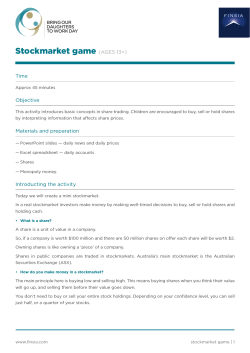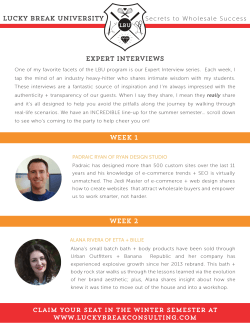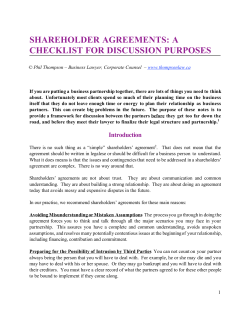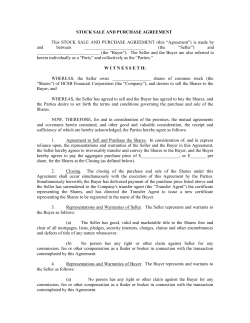
What is a Stock? Suggested Grade & Mastery Level Suggested Time Teacher Background
What is a Stock? Suggested Grade & Mastery Level High School - all levels Suggested Time 50 minutes Teacher Background When you buy stock you become part owner of a public company—no matter how many shares you own. If the stock price exceeds what you paid for it, your investment increases in value. If the stock price goes lower than what you paid for it, your investment decreases in value. You risk only the money you invest. Not all companies are public. Private companies are composed of an individual/family or a small group of investors that have private sources for funding growth; their shares are not for sale to the general public. Mars Corp, the snack food giant, is privately held. Google, the search engine company, was privately held until 2005, when it went public, offering its stock for sale. If a company’s product or service is in great demand, demand may outstrip the ability of banks and venture capitalists (who privately supply funding) to provide money for the company’s expansion to meet that demand. At that point company leaders may decide to “go public.” Company management goes to investment bankers to negotiate an agreement to underwrite a stock offering known as an IPO (Initial Public Offering). The investment bankers buy all the shares that will be offered to the public at a set price (primary market). In other words, they underwrite the IPO. The investment bankers then sell the stock to the general public (secondary market) in the hopes of making a profit. In addition to finding underwriters, company management must register its stock with the Securities and Exchange Commission (SEC) before “going public.” Generally, companies can offer two types of stock, common and preferred. Common stock entitles the owners (called stockholders or shareholders) to collect dividends, if the company declares them. It also entitles the owners to vote in company elections and decisions. Stockholders who purchase common stock share in most of a company’s profits and losses. Stockholders who purchase preferred stock are usually guaranteed a dividend payment. This payment is made before any payments to common stock holders. If a company fails, preferred stock holders are repaid before common stock holders. Preferred stock holders do not share in most of a company’s profits or losses. Preferred stock holders also do not have any voting rights. An important difference between common stock and preferred stock is that the price of the preferred stock tends to be more stable, changing little over time, than that of common stock. Stocks are bought and sold on exchanges. The Stock Market Game program is an electronic platform in which students buy and sell simulated shares on the three different major U.S. stock © 2012 SIFMA Foundation for Investor Education. All rights reserved. 1 of 10 exchanges: the American Stock Exchange (AMEX), the New York Stock Exchange (NYSE) and the NASDAQ Stock Market. It is important for students to understand the functions and properties, advantages and disadvantages of stock in preparation for learning about risk and reward and prior to making their Stock Market Game investments. Young investors as well as old will always be faced with the question: How much risk do I want to assume when buying stock in a company? Vocabulary Common Stock: Shares of a company that do not guarantee a dividend and have more risk and volatility than preferred shares. Common stock holders have the benefit of providing shareholders with the right to vote for the board of directors as well as on issues that come before the board at the annual meeting of shareholders. Corporation: A business that is owned by stockholders and has right and responsibilities as if it were a person. Dividend: Part of a company’s profits (earnings) that it pays as money to stockholders. Earnings: The amount of money that remains after subtracting the company’s expenses from its revenue. Investor: Someone who risks funds by purchasing financial products with the hope the investments will increase in value over time. IPO: Initial Public Offering; the initial sale of stock to the public by investment bankers. Preferred Stock: Shares of ownership of a company in which the share holder is guaranteed a dividend if one is declared and whose shares are usually not as volatile as common stock. Preferred stock holders do not have voting rights in company elections and decisions. Private Company: A company that is owned by a person, family, or small group of investors that does not sell shares of stock in the company to the public. Public Company: A company that is owned by investors who buy shares of stock, partial ownership of the assets of a business, in the corporation usually through one of the stock exchanges. Risk: The chance of losing all or part of an investment. Stock: A type of security that signifies ownership in a corporation and represents a claim to a part of the company’s profits or losses. Companies usually issue stock to raise money for a variety of reasons, including expanding or modernizing their operations. Tombstone Ad: An announcement appearing in financial publications such as the Wall Street Journal announcing a company’s Initial Public Offering (IPO.) Underwriter: Typically an investment banker, buys an entire new securities issue from the company or government offering it, and resells the issue as individual stocks or bonds to the public. © 2012 SIFMA Foundation for Investor Education. All rights reserved. 2 of 10 Volatility: Indicates how much and how quickly the value of an investment, market, or market sector changes. Performance Objectives Students will be able to: • Define and give examples of: common stock, investor, risk, public corporation, private company, preferred stock, earnings and dividends. • Explain why there is risk involved in stock ownership. • Make decisions as a group on the benefits of investing in stocks verses costs/ and or loss of use of capital. • Calculate gain and loss from sample stock sales. • Explain the differences between common stock and preferred stock. • Explain how a company will “go public” by issuing an IPO. Subject Area Economics, English Language Arts, Mathematics, Social Studies, Business, Technology Materials • • • • Access to the Internet Activity Sheet 1: What is a Stock? Activity Sheet 2: Stock Market Calculations Activity Sheet 3: A Tale of two Chocolate Companies Springboard Activity Ask Which is the best sneaker on the market? Why? How do you know it is the best? If it is the best, would you want to own all or part of that company? Procedure Explain that today the class will learn how they can own parts of public companies by purchasing shares of their stock. Have students speculate why the founders of companies like Nike, Apple, and Sony—that manufacture popular products like Air Jordans, the Ipod, and PS2—gave up a portion of their ownership to sell shares to the public. Distribute Activity Sheet 1: What is a Stock? Ask the students to use the reading to define common stock preferred stock and stock exchange. © 2012 SIFMA Foundation for Investor Education. All rights reserved. 3 of 10 Ask them to explain how a stock “goes public.” After a discussion of the responses discuss the advantages and risks of purchasing stock. Novice Level: Explain to the students that they already have one of several important tools needed when purchasing stock: knowledge of products people like. Have the students, in their Stock Market Game teams; select five products with which they are familiar. Have them research: Which companies make the products? Which companies are publicly traded and which are privately held? What other products do the companies make? Each student on the team should choose a company that produces one of these five products and create a profile of that company. (See www.nyse.com or www.hoovers.com for an example of a company profile) Apprentice & Master Levels Yahoo! Finance (http://finance.yahoo.com) lists Best and Worst IPOs from the past year in their Stock Research section. Ask your students to review the lists. • Are there companies you recognize? • How did they perform (Best or Worst)? In their SMG teams have students select a company from either list and research: • What products and/or services does the company provide? • Why do you think the companies choose to go public? • What has happened to the stock price since the decision to go public? • Would you invest in this company? Grand Master Level In their SMG teams have the students visit the IPOs in the Past Year list in the Stock Research section of Yahoo! Finance (http://finance.yahoo.com). The three major US exchanges also report on new IPOs: The New York Stock Exchange (http://www.nyse.com) - click About NYSE, then Listed Companies, and then IPO Showcase. American Stock Exchange (http://www.amex.com) - Click Equities then Listed Companies, and then New Listings. The NASDAQ Stock Market (http://www.nasdaq.com) - Click IPO from the top menu bar. Have the team select two companies from the same industry and research: • What products and/or services do the companies provide? • Why do you think the company went public? © 2012 SIFMA Foundation for Investor Education. All rights reserved. 4 of 10 • Compare the results since their IPO. In which company would you invest? Why or why not? Assessment Mars Candy Company, producer of Milky Way and other candy, is privately owned. Have students write a letter to the president of Mars Candy Company explaining: • The reasons for and benefits of going public. • How a company offers its initial stock. Application Novice Level Using Activity Sheet 2: Stock Market Calculations have students complete problems 1 and 2 to practice calculating the profit or loss from sample stock sales. Apprentice & Master Level Have a student from each group play the role of a financial advisor and convince the class that the newly public company their team has researched is worth the class’ investment. Grand Master Level Mars is a privately held company that individual investors cannot own. However, Mars and Hershey are not the only candy makers out there. Have your SMG teams compare Hershey (Symbol: HSY) with Cadbury Schweppes (Symbol: CSG). • • • What products/services do both offer? What are the last trade (closing) prices for both companies? Which would your team include in its SMG portfolio? Why? Enrichment Activities Have students read Activity Sheet 3: A Tale of Two Companies. or Steve wants to invest $10,000 in PepsiCo (stock symbol PEP)—the company that makes snack foods, and beverages, including Pepsi Cola and Fritos. He must decide whether to buy common shares or preferred shares in PepsiCo. When Steve looked at the stock, its common stock shares were selling for $57.38 per share and preferred shares were selling for $71.60. Common stock shareholders are paid a dividend of $1.80 per share, while preferred stock holders earn $2.30 per share of stock. Have students give advice (oral or written) to Steve including: © 2012 SIFMA Foundation for Investor Education. All rights reserved. 5 of 10 • • • Which kind of stock do they think Steve should buy? Should Steve accept more risk by buying common shares or play it safe and purchase preferred shares of his favorite company? Justify your answer and be sure to explain the difference between common stock and preferred stock. How much Steve would earn in dividends if he invested the $10,000 in common shares and held them for at least a year? How much dividend income would he earn if he invested in preferred shares? © 2012 SIFMA Foundation for Investor Education. All rights reserved. 6 of 10 Activity Sheet 1: Answer Key Stocks represent a share of ownership in a publicly held company. Private companies do not issue stock. As a stockholder, the investor has a claim on the assets of the company in exchange for money paid for the stock. The stockholder also shares with the original owners in the company’s wealth along with the risks. No matter how few shares of stock you own, you are part owner of the company. Most people buy stock to make money by: earning dividends (cash paid to investors from the company’s profits) or selling the stock at a higher price. Shareholders have limited liability: they can only lose the money they invested in the company should the corporate fail. Stockholders should make investment decisions based upon their “risk tolerance.” A number of issues contribute to an investor’s overall risk tolerance, including the investor’s age, health and their overall financial outlook. An investment with some risk but great potential for return might be a good investment for someone who is 28 and financially stable, but not for someone who is sixty and plan to retire in five years. Before you can buy stock or invest in a company, it has to “go public.” If a company’s product or service is in great demand, that demand may outstrip the ability of banks and venture capitalists (investors who privately provide money) to fund company expansion required to keep pace with the rapidly growing demand for the company’s product or service. When this happens, the company’s management may decide to “go public.” First, they find an investment banker to underwrite their stock offering, known as an IPO (Initial Public Offering). The investment banker buys all the company’s shares of stock at a set price (primary market), thus underwriting the offering. The investment banker then sells the stock to the general public (secondary market) to make a profit. In addition to preparing a prospectus, underwriters also prepare what is known as a tombstone ad (an announcement) that appears in financial publications such as the Wall Street Journal. The underwriters may also organize meetings with people who buy large amounts of stock for institutions such as pension funds, mutual funds, banks or insurance funds that they hope will buy shares in the company. There are two basic forms of stock: common and preferred. Common stock provides its holder with the right to vote on major company issues and on who will serve on the company’s board of directors. Common stock is usually more prone to rapid changes in its value than is preferred stock. Therefore, there is more risk associated with common stock than preferred. Holders of preferred stock usually do not have voting rights and the stock usually does not grow or drop in value as much as common stock. It is usually more expensive than common stock. If the company issues dividends, preferred stock holders are always paid first—before holders of common stock—and they are guaranteed a portion of the profits if dividends are declared. Each type of stock has benefits and drawbacks. Both common and preferred stocks are bought and sold in the same manner. A company may offer both common and preferred stocks. Both common and preferred stock signify ownership in the issuing company. Both common and preferred stock are traded on stock exchanges. © 2012 SIFMA Foundation for Investor Education. All rights reserved. 7 of 10 A stock exchange provides a platform (live, electronic, or both) for investors to buy and sell stock with each other. There are three major US stock exchanges: the American Stock Exchange, the NASDAQ Stock Market, and the New York Stock Exchange. Each exchange has its own listing standards, rules, and methods of operation. Companies and underwriters take great care in deciding which exchange to list or trade their stock on. Team Questions: Decide whether each of the following statements is true or false. Earn bonus points by writing a reason or example to prove a true answer or by correcting a false statement. 1. ___F__ Stockholders can only make money by collecting dividends. 2. ___F__ People who invest in the stock market will automatically make money. 3. __T_ You can only buy stock in publicly held companies. 4. __F___ Preferred stock means the company is preferred over other companies in a industry. particular 5. ___T__ A dividend is a portion of the company’s profits paid to its shareholders. 6. ___F__ Profits represent ownership of shares of a company. 7. __F___ Risk is only associated with the purchase of common stocks. 8. ___T__ A person who is 25 should not be willing to take the same amount of risk when investing as someone who is 55. 9. ___F__It is possible for stockholders to lose money in addition to the amount they invested, if a company fails. 10. __F___ A tombstone ad is prepared for companies that are facing bankruptcy and financial failure. 11. __F___ Investment bankers buy shares of stock on the same type of market that the general public does. 12. ___F__The general public buys new issues of stock on the primary market. © 2012 SIFMA Foundation for Investor Education. All rights reserved. 8 of 10 Activity Sheet 2: Answer Key Now that you know how to calculate the dividend payment on a stock and you can calculate profits and losses on sales of stock in your portfolio, you should be able to solve the following problems. 1. You purchase 723 shares of Nike at $47.75 per share and one year later you are ready to sell your 723 shares for the current market price of $62.25. Did you earn a profit or lose money from this stock sale? How much money did you make or lose? Explain how you calculated your answer. The profit from the sale of each share of stock is calculated by subtracting the cost per share which was $47.75 for the sale price of $62.25, equaling $14.50. Then you multiply the profit times the 723 shares which is $10,483.50. 2. During the year you own Nike stock you earn a dividend of $ 1.25 per share. You own 720 shares. How much did you earn in dividends? How did you arrive at your answer? You need to multiply the dividend of $1.25 per share times the number of shares which is 720. The result is an earning of $900. 3. Starbucks Coffee was selling for $57.12 per share eighteen months ago and you purchased 250 shares. You sold your shares last week for $68.38 per share. How much profit did you make on the sale? Explain your answer. You again subtract the cost which is $57.12 per share from the selling price which is $68.38 per share. You then take the resulting profit of $11.26 and multiply it times the number of shares which is 250. This means there is $2,815 in profit. 4. You own 100 shares in each of three companies. Each company pays a dividend. Gillette pays $1.15 per share in dividends. General Electric pays $.79 per share in dividends. Hershey Foods pays $ .84 per share in dividends. How much do you collect in dividends from all three companies? Explain how you got your answer. You multiply each price times 100, which represents the number of shares. You then add up $115 + $79 + $84 which is $278 in dividends. © 2012 SIFMA Foundation for Investor Education. All rights reserved. 9 of 10 5. Using the information from questions #1 and #3, what was your total profit from the sale of both these companies? Using the information provided in questions #2 and #4, what were your total earnings from dividends? You will need to add the sale of stock profit of $10,483.50 and $2815 to get $13,298.50. You will need to add the $900 + $278 to get $1,178 in dividend profit. Activity Sheet 3: Answer Key Based on the reading above answer the following questions: Explain what you think it means that Mars is a privately held company and Hershey is a publicly held company. • Mars is only owned by the family whereas Hershey is owned by a group of stockholders and is run by a Board of Directors. You can buy stock in Hershey, but you can’t buy stock in the Mars Company. If the Mars Corporation wanted to raise the money to expand its business, how could they do it? The Mars Corporation would have to go to banks or private investors to get funds to raise the money to expand its business. How can the Hershey Corporation raise funds to expand its business? • The Hershey Corporation can sell more shares of stock since it is a publicly traded company. Mars is an 18-billion dollar privately owned business; Hershey is only a 9 billion dollar publicly owned business. How could Hershey sell more candy and chocolate than Mars and still be the smaller of the two companies? Discuss and write your answers. • The Hershey Company could give away more of its money to charity and also not develop as many different types of snack foods at the Mars Corporation. © 2012 SIFMA Foundation for Investor Education. All rights reserved. 10 of 10
© Copyright 2025


















